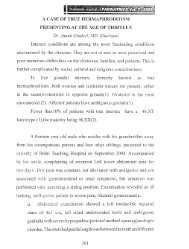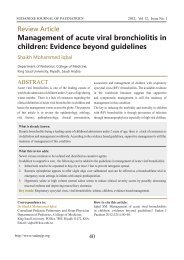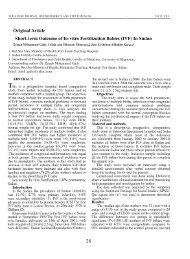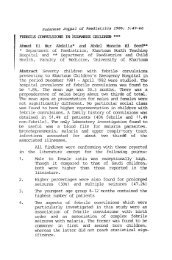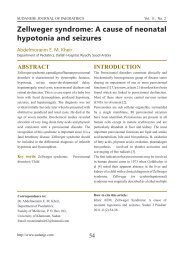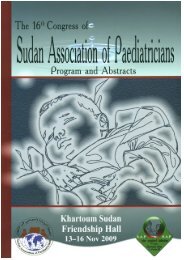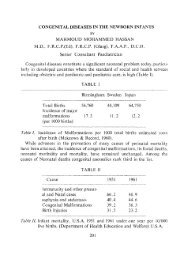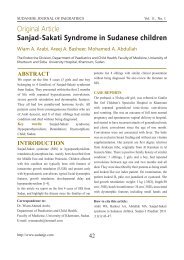Cerebral Malaria in Children: A Review of ... - Sudanjp.org
Cerebral Malaria in Children: A Review of ... - Sudanjp.org
Cerebral Malaria in Children: A Review of ... - Sudanjp.org
You also want an ePaper? Increase the reach of your titles
YUMPU automatically turns print PDFs into web optimized ePapers that Google loves.
SUDANESE JOURNAL OF PAEDIATRICS AND CHILD HEALTH VallO: 2010metastasis, transplant rejection, stroke, bra<strong>in</strong> hypoxiaand related conditions. Indeed, platelets have beendetected dur<strong>in</strong>g rejection episodes41InvolvementTumor necrosis<strong>of</strong> Cell Adhesion Moleculesfactor can <strong>in</strong>duce or upregulatevarious cell adhesion molecules(CAM)on endothelialcells; the expression <strong>of</strong> these molecules was analyzedby immunohistochemistry.with CM showed a marked upregulationBra<strong>in</strong> vessels from mice<strong>of</strong> ICAM-1and vascular cell adhesion molecule 1(VCAM-1).42An attempt to prevent CM by <strong>in</strong>travenous<strong>in</strong>jection <strong>of</strong> anti-TNF monoclonalantibodies(MAbs)directed aga<strong>in</strong>st LFA-1, Mac-I, ICAM-I, VCAM-I,VLA-4 and P-select<strong>in</strong>;MAb proved to be efficient.showed that only anti-LFA-1The important role <strong>of</strong>ICAM -1 was confirmed us<strong>in</strong>g a SCID mouse model<strong>in</strong> which P. falciparum-<strong>in</strong>fectedto bra<strong>in</strong> ICAM-Ideficient mice.43human RBC adhereand more recently us<strong>in</strong>g ICAM-1-An adhesion molecule CD36 also known asplatelet glycoprote<strong>in</strong> IV or IIIb, is an 88 kDamembrane prote<strong>in</strong> expressed on the surface asmulti-ligandreceptor <strong>of</strong> a wide variety <strong>of</strong> cell typessuch as platelets, endothelial cells, monocytes andmacrophages. It is <strong>in</strong>volved <strong>in</strong> host defense aga<strong>in</strong>st P.falciparum. CD36 is commonly deficient, particularly<strong>in</strong> certa<strong>in</strong> ethnic groups <strong>in</strong>clud<strong>in</strong>g Africans. Its role <strong>in</strong>CM is debatable.44Obstruction to the cerebral microcirculationresults<strong>in</strong> hypoxia and <strong>in</strong>creased lactate production due toanaerobic glycolysis. The parasitic glycolysis mayalso contribute to lactate production. In patients withCM, C.S.F. lactate levels are high and significantlyhigher <strong>in</strong> fatal cases than <strong>in</strong> survivors. The adherenterythrocytes may also <strong>in</strong>terfere with gas and substrateexchange throughout the bra<strong>in</strong>. However, completeobstruction to blood flow is unlikely, s<strong>in</strong>ce thesurvivors rarely have any permanent neurologicaldeficit.The mechanism<strong>of</strong> coma is not clearly known.Increased cerebral anaerobic glycolysis, <strong>in</strong>terferencewith neurotransmission by sequestered andhighly metabolically active parasites has beenblamed. Cytok<strong>in</strong>es <strong>in</strong>duce a potent <strong>in</strong>hibitor <strong>of</strong>neurotransmission, nitric oxide (NO), synthesis<strong>in</strong> leukocytes, smooth muscle cells, microglia andendothelium.Cl<strong>in</strong>ical Manifestations<strong>Cerebral</strong> malaria is an acute widespread disease <strong>of</strong>the bra<strong>in</strong> which is accompanied by fever. In severe P.falciparum malaria the neurological dysfunction canmanifest suddenly follow<strong>in</strong>g a generalized seizureor gradually over a period <strong>of</strong> hours.46The cl<strong>in</strong>icalmanifestations however, are numerous but there arethree primary symptoms generally common to bothadults and children:(1) Impaired consciousness with non-specific fever,(2) Generalized convulsions and neurologicalsequelae and,(3) Coma that persists for24 -72% hours, <strong>in</strong>itiallyarousable and then unarousable.Neurological Signs <strong>in</strong> <strong>Cerebral</strong> <strong>Malaria</strong>:Mild neck stiffness may be seen, however,neck rigidity and photophobia and signs <strong>of</strong>raised <strong>in</strong>tracranial pressure are absent. Ret<strong>in</strong>alhaemorrhages occur <strong>in</strong> about 15% <strong>of</strong> cases, exudatesare rare. Pupils are normal. Papilloedema is rareand should suggest other possibilities. A variety <strong>of</strong>transient abnormalities <strong>of</strong> eye movements, especiallydysconjugate gaze are observed. Fixed jaw closureand tooth gr<strong>in</strong>d<strong>in</strong>g (bruxism) are common. Pout<strong>in</strong>g orshow<strong>in</strong>g displeasure may occur or may be elicitable,but other primitive reflexes are usually absent. Thecorneal reflexes are preserved except <strong>in</strong> a case <strong>of</strong> deepcoma. Motor abnormalities like decerebrate rigidity,decorticate rigidity and opisthotonus can occur. Deepjerks and plantar reflexes are variable. Abdom<strong>in</strong>aland cremasteric reflexes can not be elicited. Thesesigns help <strong>in</strong> dist<strong>in</strong>guish<strong>in</strong>g CM from behaviouralproblems due to fever <strong>of</strong> other causes. Rarely, cases19



